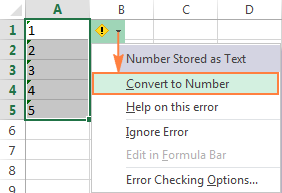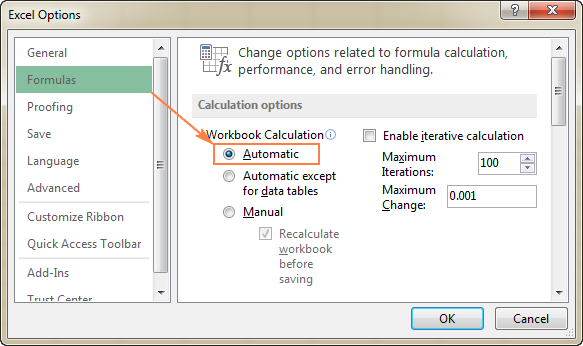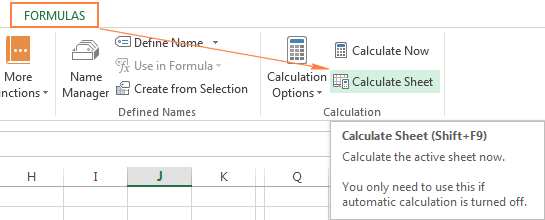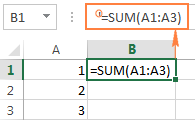This tutorial explains the most common mistakes when making formulas in Excel, and how to fix a formula that is not calculating or not updating automatically.
Can someone imagine using Microsoft Excel without formulas? I believe no one can. And hardly anything could compare to the frustration caused by Excel formulas stop working all of a sudden. When this happens, a bunch of questions immediately flash across your mind. Why is my Excel formula not calculating? Why doesn't this formula update its value automatically? Is my Excel corrupt or is this due to some malicious virus? And how do I get my Excel to calculate and update formulas automatically again? Don't worry, most likely your Excel is all right, and you will get all the answers in a moment.
Excel formulas not working
Symptoms: Excel formula not working correctly, it returns an error or a wrong result.
This section provides a summary of the most common mistakes people make when creating formulas in Excel and solutions to fix them.
1. Match all opening and closing parentheses in a formula
As you know, the arguments of Excel functions are entered within the parentheses. In complex formulas, you may need to enter more than one set of parentheses, one within another, to indicate the order in which the calculations should take place. When creating such a formula, be sure to pair the parentheses properly so that you always have a right parenthesis for every left parenthesis in your formula.
Microsoft Excel displays the parentheses pairs in different colors as you enter them in a formula. If your formula is short of one or more parentheses, Excel displays an error message and suggests a correction to balance the pairs. Please see How to highlight and match parenthesis pairs for more information.
2. Enter all required arguments in an Excel function
All Excel functions have one or more required arguments. Some functions also have optional arguments, which are enclosed in [square brackets] in the formula's syntax.
A formula must contain all of the required arguments, otherwise Excel displays "You've entered too few arguments for this function" alert.
If you have entered more arguments than allowed by the formula's syntax, you will get "You've entered too many arguments for this function" error message.
3. Do not nest more than 64 functions in a formula
When nesting two or more Excel functions into each other, e.g. creating a nested IF formula, remember about the following limitations:
- In Excel 2016, Excel 2013, Excel 2010 and Excel 2007, you can use up to 64 nested functions.
- In Excel 2003 and lower, only up to 7 nested functions can be used.
4. Don't enclose numbers in double quotes
In Excel formulas, any value enclosed in double quotes is interpreted as a text string.
What it means is that if you enter a formula like =IF(A1>0, "1"), Excel will treat number 1 as text, and therefore you won't be able to use the returned 1's in other calculations. To fix this, just remove the double quotes around "1": =IF(A1>0, 1).
So, whenever you are writing a formula for numerical values, follow this simple rule: don't enclose numbers in double quotes unless you want them to be treated as text.
5. Enter numbers without any formatting
When using a number in an Excel formula, don't add any decimal separator or currency sign like $ or €.
Remember that in Excel formulas, a comma is typically used to separate a function's arguments, and the dollar sign makes an absolute cell reference.
For instance, instead of entering $50,000 in your formula, input simply 50000, and use the Format Cells dialog (Ctrl + 1) to format the output to your liking.
6. Make sure numbers are not formatted as text values
Numbers formatted as text values are another common reason for Excel formulas not working. At first sight, they look like normal numbers, but Microsoft Excel perceives them as text strings and leaves out of calculations.
The visual indicators of text-numbers are as follows:
- Numbers formatted as text are left-aligned by default, while normal numbers are right-aligned in cells.
- The Number Format box on the Home tab in the Number group displays the Text format.
- When several cells with text numbers are selected on the sheet, the Status Bar only shows Count, while usually it shows Average, Count and SUM for numbers.
- There may be a leading apostrophe visible in the formula bar, or green triangles appear in the top-left corner of the cells.
The below screenshot shows that even a simple Excel SUM formula may not work because of numbers formatted as text:

To fix this, select all problematic cells, click the warning sign, and then click Convert to Number:

In some cases, however, neither green triangles nor the warning sign appear in cells. For example, if you enclose numeric values in double quotes in your formulas, Excel assumes you want to output a text string rather than a number.
At first sight, the following formula appears to be working fine:
=IF(A1="Good", "1", "0")
But the problem is the returned 1's and 0's are text values, not numbers! And if you reference any cells with the above formula in other formulas, those cells won't be included in calculations. As soon as you remove "" surrounding 1 and 0 in the above formula, Excel will treat the outputs as numbers and they will be calculated correctly.
If the small green triangles do not appear in cells for some other reason, look at the Number Format box on the Home tab in the Number group. If it displays Text, try clearing all formatting for the problematic cells, and set the cells' format to Number or General. If that doesn't work, you might have to create a new column, manually input the data (e.g. copy your text-numbers to Notepad, and then back to a new column), and delete the broken column.
Another possible solution is to multiply the values in the problematic column by 1 using a simple formula like =A1*1. And then, copy the formula cells and paste them as values in the same or in any other column via Paste Special > Values.
7. Separate function arguments with a proper character
Most of us are used to separating function arguments with commas. However, this does not work for everyone's Excel. The character you use to separate arguments depends on the List Separator set in your Regional Settings.
Comma is the default list separator in North America and some other countries. In European countries, comma is used as the decimal symbol and the list separator is usually set to semicolon.
For example, in North America you would write =IF(A1>0, "OK", "Not OK"), while European users of Excel should put the same formula as =IF(A1>0; "OK"; "Not OK").
So, if your Excel formulas are not working because of "We found a problem with this formula..." error, go to your Regional Settings (Control Panel > Region and Language > Additional Settings) and check what character is set as List Separator there. And then, use exactly that character to separate arguments in your Excel formulas.
8. Enclose workbook and worksheet names in single quotes
When referring to other worksheets or workbooks that have spaces or non-alphabetical characters in their names, enclose the names in 'single quotation marks'. For example,
Reference to another sheet:
=SUM('Jan Sales'!B2:B10)
Reference to another workbook:
=SUM('[2015 Sales.xlsx]Jan sales'!B2:B10)
For more information, please see How to refer to another sheet or workbook in Excel.
9. Include the full path to a closed workbook
If you are writing a formula that references a closed Excel workbook, your external reference must include the workbook name and entire path to the workbook. For example:
=SUM('D:\Reports\[Sales.xlsx]Jan'!B2:B10)
For more information, please see Creating a reference to another workbook.
If the above tips do not help, try to evaluate and debug each part of your formula individually by using the F9 key and other debugging techniques explained in the following tutorial: How to evaluate and debug formulas in Excel.
Excel formulas not updating
Symptoms: The value returned by your Excel formula does not update automatically, i.e. the formula continues to show the old value even after you've changed the values of the dependent cells.
When Excel formulas are not updating automatically, most likely it's because the Calculation setting has been changed to Manual instead of Automatic. To fix this, just set the Calculation option to Automatic again.
On the Excel ribbon, go to the Formulas tab > Calculation group, click the Calculation Options button, and select Automatic:

Alternatively, you can change this setting in Excel Options:
- In Excel 2003, click Tools > Options > Calculation > Calculation > Automatic.
- In Excel 2007, click Office button > Excel options > Formulas > Workbook Calculation > Automatic.
- In Excel 2010, Excel 2013, and Excel 2016, go to File > Options > Formulas > Calculation options section, and select Automatic under Workbook Calculation.

How to force Excel formulas to recalculate
If for some reason, you need to have the Calculation option set to Manual, you can force the formulas to recalculate by clicking the Calculate button on the ribbon or by using one of the following shortcuts:
To recalculate the entire workbook:
- Press F9, or
- Click the Calculate Now button on the Formulas tab > Calculation group.
To recalculate an active sheet:
- Press Shift + F9, or
- Click Calculate Sheet on the Formulas tab > Calculation group.

To recalculate all sheets in all open workbooks, press Ctrl + Alt + F9.
If you need to recalculate only one formula on a sheet, select the formula cell, enter the editing mode either by pressing F2 or double clicking the cell, and then press the Enter key.
Excel formulas not calculating
Symptoms: A cell displays the formula, not the result.
If your Excel formula is not working because a cell displays the function instead of the calculated value, it's because one of the following reasons.
1. Show Formulas mode is turned on
The most common reason for an Excel formula not calculating is that you have inadvertently activated the Show Formulas mode in a worksheet.
To get the formula to display the calculated result, just turn off the Show Formulas mode by doing one of the following:
- Pressing the Ctrl + ` shortcut, or
- Clicking the Show Formulas button on the Formulas tab > Formula Auditing group.

2. A formula is entered as text
Another frequent reason for your Excel formula not calculating is that the formula has been formatted as text. To check this, select the formula cell, and look at the Number Format box in the Number group on the Home tab:

If it is the case, change the cell format to General, and while in the cell press F2 and Enter for the formula to recalculate and display the calculated value.
3. A formula cell has a leading space or apostrophe before the equal sign
If you have inadvertently entered a space or apostrophe (') before the equal sign, Excel treats the cell contents as text, and consequently does not evaluate any formula within that cell (a leading space often appears when you copy a formula from the web). To fix this, just remove the leading space or single quote.

This is how you deal with formulas not working in Excel. If you know any other solutions to fix formulas not updating or not calculating, please do share in comments. I thank you for reading and hope to see you on our blog next week.
 by
by
451 comments
I have an SQL query that I run in SQL Management studio and then paste into Excel. Parts of that query include some excel formulas like VLOOKUP(...) or Hyperlink(...) as well as data from the database.
When I copy and paste these rows into excel, the formulas evaluate just fine. But now I am trying to build that query into the spreadsheet using data connections and the formulas are not being treated as formulas. The cells are formatted as General. The formulas start with =. If I click on the formula cell, pretend to edit it (making no edits) and then press enter, it calculates. But I don't want to do that twice per row ~ 1000 times.
Found a workaround. Do a find-replace of = with =
That triggers the calculation. But it still isn't a permanent fix.
DITTO to #77 ! Frustration OVER !
Hello anyone, I am trying to work out my mpg by using the formula =sum(E18/b18) and I get value instead of an answer. The whole line is 24.28Litres costing 117.7 totalling 28.58 with 213.2 miles. Why do I get value rather than a result? I was using Libra which did the calculation and switched to MS 365 which doesn't.
last 20years am using excel, i just confused suddenly my formulas not working, after i searched google.... and i found this page, its great to have such solution (switching calculation back from manual to automatic),thank you dear
Thanks for this, my excel formulae were not working this morning and it was indeed a terrifying experience, great to have such a simple solution (switching calculation back from manual to automatic)
Hi my excel sheet contains addition formula for a particular date and that date is linked with other formulas.
but even single is not working out what might be the probable cause ?
Your article assumes a "mistake" was made in entering formulas.. I have used Excel for years and now it doesn't work... no mistake made. Call it what it is a huge Microsoft BUG! It will no longer copy formulas down a column using relative and absolute values either!
I want to thank you very much. I was sick to my stomach when I came in today and tried to use my spreadsheet that I developed for use every day only to find out that some rather complex formulas had stopped working. I had a glitch in my computer yesterday causing one of my displays to rotate 90 degrees CCW. Apparently it also caused some changes in my Excel settings. After reading your information I was able to quickly determine that it had switched from automatic calculation to manual. Easy fix. Thanks again.
Thanks, it was in 'Text' format.
thank you for wonderful information
When I am typing 1 in excel sheet. It is turning 0.01 automatically. Why is it so? Can anybody help me? And when typing 100 then ist 1.
thanks..:)
That was really helpful.. thanks
when i am using multiplication in excel 2016 - 2.5*5.4 that showing error only showing decimal number
Wow, that was a hassle. I had a column of mixed text and numbers, but the answer for COUNT() was always one less than it should have been. I tried the other solutions, finally used the trick of copying the column to a notepad file and pasting it back to a new column, and now I get the right count. (I used Paste Special just to be sure, although I'm not sure it was necessary.)
One note: I didn't see a Paste Special > Values option on Excel 2010. Paste Special > had the options "Unicode Text" and "Text". I used Text because that was the unformatted option.
I have been using time formulas to track specific activities in my job. I have a column for date, beginning time, ending time, net time by subtracting end from beginning and then at the end of week add up activities total time for the week.
For the first 3 weeks it worked perfectly but at the 4th week the summ for the week quite working. I copied the formula from above, updated the cells to sum for that week and now week 4 comes up with 0 hours thought the hours each day are 5:30, 5, 6:30, 3:30 and 3:30 and the fifth week sums 3:30 though the sells being summed are 8,8,9,2:30. Those are all formatted as hours and minutes so show hh:mm though I only gave absolute values. What could have gone wrong?
Thank you.
Calculation option was changed!!!!
I updated to automatic.....
curse the shared file!!! :)
great!
Thanks
Good morning - I am using Power Query linked to Sales Force reports and the data is shown in a table. I added 3 of my own formulas in the table to the right of the last column. When I open the file and refresh the data new rows of data are added daily but the formulas I created do not copy down in the table. Is this a setting I need to change or is there a way to correct?
Thank you
Hi!
Im trying to get a result on these formulas:
=DATEIF(C2<=D2,"On Time","Late Arrival")
=IF(C2<=D2,"On Time","Late")
But I get an error message. What could be wrong? I have dates in date format (2016-12-22) in C2 and D2. My aim is to compare to dates and generate the text On time and Late as a result.
Thank you a lot!
Hi Jenny,
In Microsoft Excel, there is no DATEIF function. You probably meant DATEDIF, but it is designed for finding a difference between 2 dates and has a different syntax, please check here.
Your IF formula is correct and works just fine for me. Exactly what error message does it throw in your sheet?